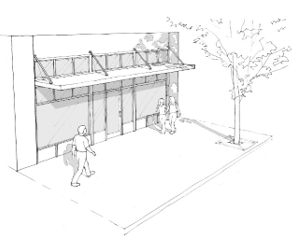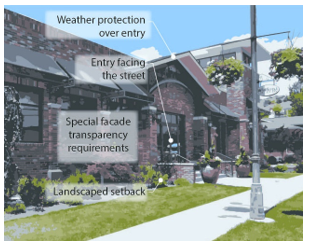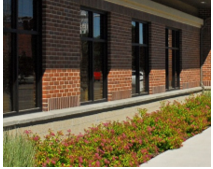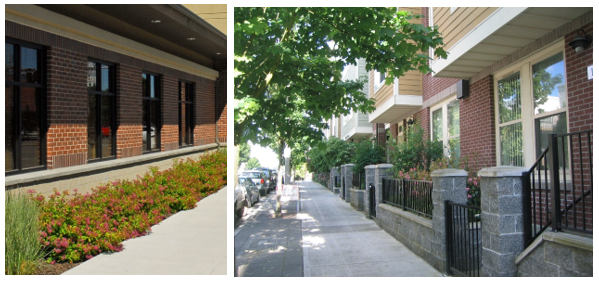19.61.080 Mixed block frontage standards.
A. Purpose. Mixed block frontages allow for general flexibility where either a storefront orientation or a landscaped orientation in a pedestrian-friendly configuration could be developed.

|
OR |

|
B. Standards. Development must conform to either storefront or landscaped block frontage standards and associated departure options and departure criteria as established above, with only the following modifications in Table 19.61.080(B) below:
|
The ⮊ symbol refers to DEPARTURE opportunities in subsection (C) below. |
||
|
Element |
Standards |
Examples and Notes |
|
Building placement |
Buildings may be placed up to the sidewalk edge, provided they meet storefront block frontage standards in AMC 19.61.060 (this includes standards for ground level, building placement, building entrances, facade transparency, and weather protection elements). The minimum setback for buildings that do not meet applicable storefront block frontage standards is 10' or greater where specified for the applicable zone in AMC Chapter 19.42, Form and Intensity Standards. ⮊ |
|
|
Facade transparency |
Storefront buildings are subject to storefront block frontage transparency standards above. For other building frontages, transparent windows must be provided along at least 15% of the building facade, plus: • Buildings designed with ground floor nonresidential uses within 10' of sidewalk must feature at least 40% transparency within the transparency zone. ⮊ • Buildings designed with ground floor nonresidential uses within 20' of sidewalk must feature at least 25% transparency within the transparency zone. ⮊ |

This office building (within 10' of sidewalk) would need at least 40% transparency within the 30'' to 8' transparency zone. |
C. DEPARTURE Criteria. Departures to the mixed block frontage standards in Table 19.61.080(B) that feature the ⮊ symbol will be considered per AMC 19.20.220, provided the alternative proposal meets the purpose of the standards and the following criteria:
1. Building Placement. Provide design treatments that create an effective transition between the public and private realm. For example, a stoop design or other similar treatments that utilize a low fence or retaining wall and/or hedge along the sidewalk may provide an effective transition (see Figure 19.61.080(C) for examples).
2. Facade Transparency. Facade transparency in the transparency zone may be reduced from the minimum by 50 percent if the facade design between ground level windows provides visual interest to the pedestrian and mitigates the impacts of blank walls.

The landscaped and stoop frontages above are possible departure examples with reduced setbacks for non-storefront facades. The combination of landscaping elements, facade transparency, low fencing, and facade materials and detailing help to create an effective transition between the public and private realm. |
(Ord. 3040 § 2 (Att. A), 2019)